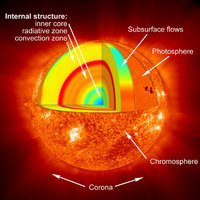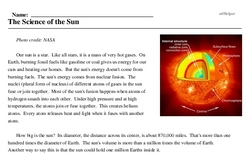The Science of the Sun
Photo credit: NASA
Our sun is a star. Like all stars, it is a mass of very hot gases. On Earth, burning fossil fuels like gasoline or coal gives us energy for our cars and heating our homes. But the sun's energy doesn't come from burning fuels. The sun's energy comes from nuclear fusion. The nuclei (plural form of nucleus) of different atoms of gases in the sun fuse or join together. Most of the sun's fusion happens when atoms of hydrogen smash into each other. Under high pressure and at high temperatures, the atoms join or fuse together. This creates helium atoms. Every atom releases heat and light when it fuses with another atom.
How big is the sun? Its diameter, the distance across its center, is about 870,000 miles. That's more than one hundred times the diameter of Earth. The sun's volume is more than a million times the volume of Earth. Another way to say this is that the sun could hold one million Earths inside it.




